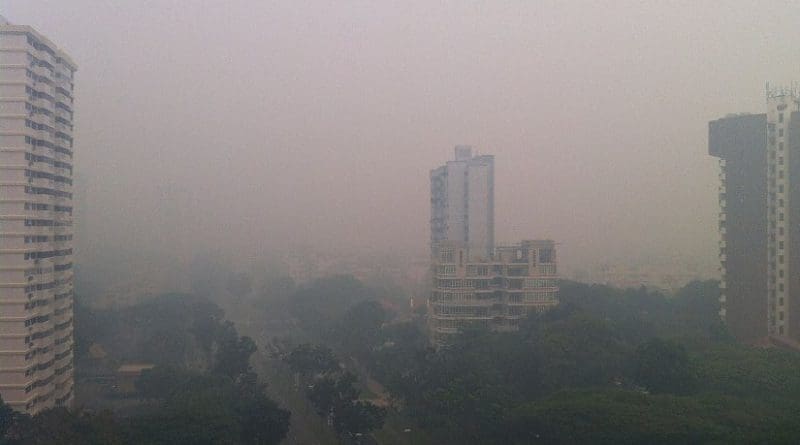Here Comes The Haze, Yet Again: Are New Measures Working? – Analysis
By RSIS
The current episode of haze is the first after Indonesia ratified the ASEAN agreement to tackle haze pollution in 2014. It is also the first after Singapore’s Transboundary Haze Pollution Act 2014 came into effect. The region’s new battle plan against transboundary haze pollution is being put to the test.
By Margareth Sembiring*
With the onset of the El Nino season, forest fires in some Sumatran and Kalimantan provinces of Indonesia have generated thick clouds of haze across the Malacca Strait. Just within the past week, thick haze has paralysed airports in Pekanbaru, Batam, Kualanamu (Medan), Aceh, and Jambi, with incoming and outgoing flights getting delayed for hours or cancelled altogether.
Schools were also closed for days to allow school children to stay at home and minimise their exposure to the smog. Concurrently, the PSI readings in Singapore have worsened over the past few days. The recurrence of haze is expected although by no means acceptable. Haze incurs hefty costs on health and the economy, and it often strains Singapore-Indonesia relations.
Recurrence despite troubleshooting
For years, numerous efforts have been taken to address forest fires issues in Indonesia’s affected provinces. Among other initiatives, Indonesia has put land and/or areas prone to forest fires under surveillance; collected data and information relating to hotspots and the spread of haze; mapped burnt areas; and used the Fire Danger Rating System (FDRS) to monitor forest fires risk.
Additionally, Indonesia has developed standard operating procedures in preventing and suppressing land and/or forest fires; strengthened and raised community awareness through public education; introduced early prevention activities or trainings; strengthened the institutions and legislations that support zero burning policy; and coordinated law enforcement across different agencies, including the Corruption Eradication Committee (KPK) and the National Police.
Forest fires in Riau Province which severely enveloped Singapore and parts of Malaysia in mid-2013 were even regarded as a national emergency during which time the National Agency for Disaster Management (BNPB) was called upon to suppress the fires.
To complement its domestic efforts, Indonesia forged bilateral cooperation with Singapore and Malaysia to build local capacity in dealing with forest fires in Jambi and Riau provinces respectively. Indonesia also takes part in the ASEAN Peatland Management Strategy (2006 – 2020), a regional initiative aimed at managing community livelihood on peatland thereby preventing forest fires.
Despite these continuing efforts, the haze has recurred. Myriad factors can explain this. They include deep-seated economic interests in slash-and-burn techniques; lack of fire suppression systems deep in the forests; and the sheer size of fire-prone areas and limited capacity to access and protect them. Overlapping land claims add on to the complexity of forest fires and resultant haze problem.
What’s new?
Just before former President Susilo Bambang Yudhoyono ended his term in October 2014, the Indonesian Parliament finally ratified the ASEAN Agreement on Transboundary Haze Pollution. The ratification generated mixed reactions, with some perceiving it as a positive development after 12 years of waiting, while others regarded it as nothing more than signing a non-enforceable agreement.
His successor President Joko Widodo merged the ministries handling the environment and forestry with the hope of improving bureaucratic coordination and improving efficiency in responding to environmental and forestry issues including forest fires and the haze pollution triggered. A coalition of environmental groups in Indonesia, however, has cautioned that such merger would only further complicate inter-sectoral coordination.
During the same period, the Singapore parliament passed the Transboundary Haze Pollution Act 2014. The Act aims to deter companies or entities operating in or outside Singapore from taking part in activities that contribute to transboundary haze affecting Singapore.
Critics, however, have pointed out that the effectiveness of the new law would largely depend on the ability to accurately identify errant companies or entities, as well as on law enforcement and cooperation from the Indonesian counterparts. Indonesia’s overlapping concession maps have often been cited as one of the main reasons that hinder law enforcement efforts in affected areas.
In December 2014, Indonesia launched the much anticipated One Map of National Thematic Geospatial Information. It put into effect the One Map Policy which was mandated in an Act on Geospatial Information three years earlier. As the One Map attempts to create one reference, one standard, one database, and one portal for otherwise various and often overlapping maps, the One Map is expected to provide a better avenue for stronger cooperation and coordination for national development including responses to forest fires and the resulting haze.
How different would things be?
The current episode of haze, therefore, is the first to occur after these major measures were taken in Indonesia and Singapore. How different would things be now?
Criticisms have been levelled against the new initiatives when they were first introduced. With the fast thickening smog in Singapore and parts of Indonesia’s Sumatran and Kalimantan provinces, it is timely for both governments to prove that their policies do work. Ultimately, bringing the real culprits before justice, suppressing the fires quickly, minimising future occurrences of forest fires, and making the region haze-free are the real indicators of success of those measures.
*Margareth Sembiring is a Senior Analyst at the Centre for Non-Traditional Security (NTS) Studies, S. Rajaratnam School of International Studies (RSIS), Nanyang Technological University, Singapore.

